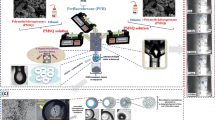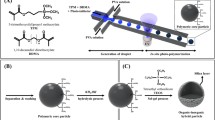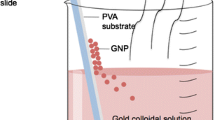Abstract
Solid polymer nanospheres with contrasting size and surface roughness were prepared using a V-shaped microfluidic junction device. Polymethysilsesquioxane (PMSQ) polymer dissolved separately in either methanol, or ethanol, or propanol or butanol was used, and the nanospheres produced were collected in distilled water at two different temperatures (23°C and 100°C). Each polymer solution together with a volatile liquid, perfluorohexane, was fed into the inlet channels of the microfluidic device. The process of nanosphere generation was recorded by high-speed camera imaging. Only PMSQ solutions of ethanol and propanol generated well-defined nanospheres. The influence of the solvents and the nanosphere collection temperature on nanosphere size distribution and surface roughness was assessed using scanning electron microscopy, which showed that solvent selection was crucial in tailoring the size distribution of the nanospheres and that the nanospheres collected at 100°C had a noticeably rougher surface. The temperature also helped to vary the size distribution of the nanospheres. Nanospheres containing Evans blue dye were also prepared, and those with a rough surface exhibited a very different dye release profile compared with those having a smooth surface. In fact, the release profile changes due to a size differential can be largely compensated for by having a rough surface.





Similar content being viewed by others
References
A. Kumari, S.K. Yadav, and S.C. Yadav, Colloids Surf. B 75, 1–18 (2010).
A. Lenshof and T. Laurell, Chem. Soc. Rev. 39, 1203–1217 (2010).
J.P. Frampton, M.L. Shuler, W. Shain, and M.R. Hynd, Cent. Nerv. Syst. Agents Med. Chem. 8, 203–219 (2008).
A.-J. Wang, Y.-P. Lu, and R.-X. Sun, Mater. Sci. Eng., A 460–461, 1–6 (2007).
A.S. Karakoti, L.L. Hench, and S. Seal, JOM 58, 77–82 (2006).
B. Felice, M.P. Prabhakaran, A.P. Rodríguez, and S. Ramakrishna, Mater. Sci. Eng. C 41, 178–195 (2014).
N. Saito, Y. Kagari, and M. Okubo, Langmuir 22, 9397–9402 (2006).
Y. Zhang, H.F. Chan, and K.W. Leong, Adv. Drug Deliv. Rev. 65, 104–120 (2013).
A. Zvonar, J. Kristl, J. Kerc, and P.A. Grabnar, J. Microencapsul. 26, 748–759 (2009).
N.T.K. Thanh and L.A.W. Green, Nano Today 5, 213–230 (2010).
J.-M. Lim, N. Bertrand, P.M. Valencia, M. Rhee, R. Langer, S. Jon, O.C. Farokhzad, and R. Karnik, Nanomedicine 10, 401–409 (2014).
N. Nihant, S. Stassen, C. Grandfils, R. Jérome, P. Teyssié, and G. Goffinet, Polym. Int. 34, 289–299 (1994).
S. De Koker, R. Hoogenboom, and B.G. De Geest, Chem. Soc. Rev. 41, 2867–2884 (2012).
I. Kucuk, Z. Ahmad, M. Edirisinghe, and M. Orlu-Gul, Int. J. Pharm. 472, 339–346 (2014).
C.A. Serra and Z. Chang, Chem. Eng. Technol. 31, 1099–1115 (2008).
C.-H. Choi, J.-H. Jung, D.-W. Kim, Y.-M. Chung, and C.-S. Lee, Lab Chip 8, 1544–1551 (2008).
Y. Chen, G.G.Z. Zhang, J. Neilly, K. Marsh, D. Mawhinney, and Y.D. Sanzgiri, Int. J. Pharm. 286, 69–80 (2004).
C. Wu, X. Sun, Z. Zhao, Y. Zhao, Y. Hao, Y. Liu, and Y. Gao, Mater. Sci. Eng. C 44, 262–267 (2014).
F. Alexis, Polym. Int. 54, 36–46 (2005).
S. Adiga, L. Curtiss, J. Elam, M. Pellin, C.-C. Shih, C.-M. Shih, S.-J. Lin, Y.-Y. Su, S. Gittard, J. Zhang, and R. Narayan, JOM 60, 26–32 (2008).
M. Enayati, Z. Ahmad, E. Stride, and M. Edirisinghe, J. R. Soc. Interface 7, 667–675 (2010).
I. Armentano, M. Dottori, E. Fortunati, S. Mattioli, and J.M. Kenny, Polym. Degrad. Stab. 95, 2126–2146 (2010).
Y. Song, Q. Sun, T. Zhang, P. Jin, and L. Han, J. Nanopart. Res. 12, 2689–2697 (2010).
L.E. Murr, JOM 58, 23–33 (2006).
Z. Ahmad, E. Stride, and M. Edirisinghe, J. Drug Target. 17, 724–729 (2009).
M. Zou, S. Wang, F. Huang, Z. Zhang, and X. Ge, Polym. Int. 55, 305–311 (2006).
M.W. Chang, E. Stride, and M. Edirisinghe, Langmuir 26, 5115–5121 (2010).
C.-H. Yang, C.-Y. Wang, K.-S. Huang, C.-P. Kung, Y.-C. Chang, and J.-F. Shaw, Int. J. Pharm. 463, 155–160 (2014).
J. Michael Köhler, I. Kraus, J. Faerber, and C. Serra, J Mater Sci 48, 2158–2166 (2013).
E. Kumacheva, S. Xu, Z. Nie, M.S. Seo, P.C. Lewis, and H. Zhang, US Patent 8696952 (2014).
A. Jahn, J.E. Reiner, W.N. Vreeland, D.L. DeVoe, L.E. Locascio, and M. Gaitan, J. Nanopart. Res. 10, 925–934 (2008).
C.J. Luo, M. Nangrejo, and M. Edirisinghe, Polymer 51, 1654–1662 (2010).
K. Pancholi, E. Stride, and M. Edirisinghe, Langmuir 25, 10007–10013 (2009).
S.G. Kapsi and J.W. Ayres, Int. J. Pharm. 229, 193–203 (2001).
I. Kucuk and M. Edirisinghe, J. Nanopart. Res. 16, 1–9 (2014).
C.N. Baroud, F. Gallaire, and R. Dangla, Lab Chip 10, 2032–2045 (2010).
S.T. Knauert, J.F. Douglas, and F.W. Starr, J. Polym. Sci. Part B Polym. Phys. 45, 1882–1897 (2007).
M. Eltayeb, E. Stride, and M. Edirisinghe, Nanotechnology 24, 465604 (2013).
P. Sofokleous, E. Stride, W. Bonfield, and M. Edirisinghe, Mater. Sci. Eng. C 33, 213–223 (2013).
D.S. Yun, H.J. Kim, and J.W. Yoo, Bull. Korean Chem. Soc. 26, 1927 (2005).
J.M. Crane, G. Putz, and S.B. Hall, Biophys. J. 77, 3134–3143 (1999).
Acknowledgements
The authors wish to thank The Islamic Development Bank (IDB) Merit Scholarship Programme for High Technology (MSP) for funding Israfil Kucuk’s PhD research at UCL. They are extremely grateful to Professor Paolo Colombo (University of Padova) for his helpful advice regarding the experimental work. They gratefully acknowledge the UK Engineering and Physical Science Research Council and Adrian Walker for providing the Phantom V7 high-speed camera.
Author information
Authors and Affiliations
Corresponding author
Rights and permissions
About this article
Cite this article
Kucuk, I., Edirisinghe, M. Changing the Size and Surface Roughness of Polymer Nanospheres Formed Using a Microfluidic Technique. JOM 67, 811–817 (2015). https://doi.org/10.1007/s11837-015-1343-6
Received:
Accepted:
Published:
Issue Date:
DOI: https://doi.org/10.1007/s11837-015-1343-6




